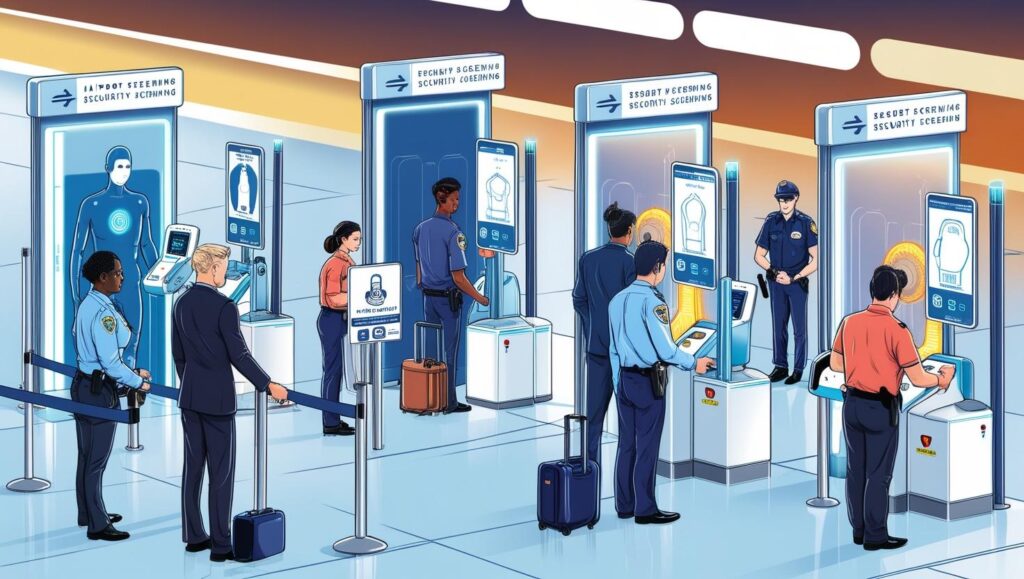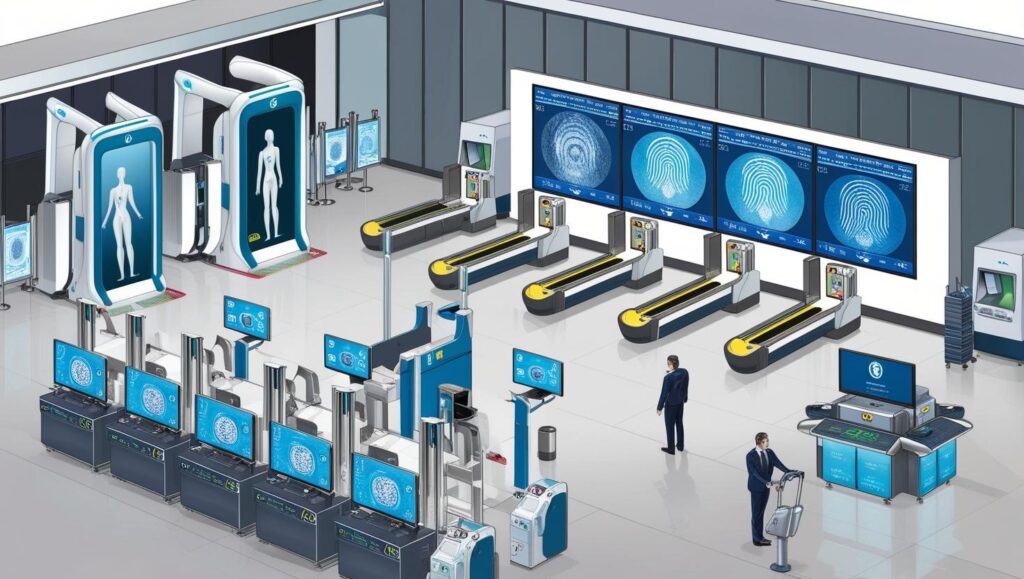The security screening landscape in North America is entering a transformative era—driven by rising threats, increased regulatory requirements, and the need for faster, more accurate, and seamless security experiences. From airports and seaports to government buildings and critical infrastructure, the demand for advanced screening systems has never been more urgent. At the center of this evolution is Artificial Intelligence (AI), which is reshaping how threats are detected, analyzed, and managed.
As the region continues to prioritize national security and public safety, the North America security screening market is set to witness significant growth, powered by technological innovation and intelligent automation.

Market Outlook: A Landscape of Heightened Demand
The North American security screening market—encompassing technologies such as X-ray scanners, metal detectors, biometric systems, explosive trace detectors, and body scanners—is expected to experience robust growth over the next several years. A combination of factors is fueling this momentum.
Firstly, the threat landscape is evolving, with more sophisticated smuggling techniques, cyber-physical threats, and public safety risks driving the need for smarter and more adaptable screening systems. Secondly, post-pandemic changes in travel, logistics, and workplace norms have increased the need for touchless, non-intrusive, and automated security checks.
Governments across the U.S. and Canada are investing in modernizing their security infrastructure, especially at transportation hubs, border checkpoints, courthouses, correctional facilities, and high-risk public venues. Meanwhile, the private sector—particularly in aviation, logistics, and commercial real estate—is accelerating its adoption of integrated, tech-driven security solutions.
AI Integration: From Automation to Intelligence
The most transformative force in the industry today is Artificial Intelligence. While automation has long been part of security screening (e.g., conveyor belts, automatic doors), AI takes it a step further—infusing machines with the ability to analyze data, detect anomalies, and make real-time decisions.
In baggage and parcel screening, AI-powered imaging systems can now identify weapons, explosives, narcotics, and contraband with higher accuracy and fewer false positives than traditional systems. These solutions use deep learning algorithms trained on vast datasets of threat signatures and innocuous objects, continuously improving their performance over time.
AI is also enhancing facial recognition and biometric verification systems, enabling secure and frictionless access control in airports, corporate offices, and secure facilities. These systems can match faces against watchlists or databases in real time, while adjusting for variables like lighting, masks, or facial changes—improving both security and convenience.
Another area seeing rapid advancement is behavioral analytics. AI-driven systems can monitor body language, heat signatures, and movement patterns to detect suspicious behavior before a threat manifests. This adds a predictive layer to traditional security operations, allowing preemptive responses rather than reactive measures.
Download PDF Brochure @ https://www.marketsandmarkets.com/pdfdownloadNew.asp?id=264685413

Applications Across Key Sectors
In aviation, AI-powered screening solutions are optimizing passenger throughput without compromising safety. Smart lane management, biometric boarding, and automated bag inspection are reducing wait times and enhancing the traveler experience. The Transportation Security Administration (TSA) in the U.S. has been piloting AI-integrated scanning systems to increase operational efficiency and accuracy.
In logistics and cargo screening, AI helps detect tampered goods, unauthorized items, and route deviations. As e-commerce booms and global supply chains face mounting pressure, these technologies ensure goods are transported securely and compliantly.
In critical infrastructure and government facilities, security screening systems are being deployed to protect data centers, military bases, nuclear plants, and administrative buildings. AI plays a crucial role in multi-layered surveillance systems, integrating video analytics, access control, and environmental monitoring.
The healthcare sector is also adopting AI-enhanced screening to manage access to sensitive areas such as pharmacies, research labs, and emergency departments—particularly amid heightened concerns about public safety and pandemic response.
Challenges and Considerations
Despite the promise, the integration of AI into security screening does present challenges. Privacy and data protection are major concerns, especially when biometric data or facial recognition is involved. Regulatory frameworks in North America are still evolving, and companies must ensure compliance with laws such as the General Data Protection Regulation (GDPR) where applicable, and emerging U.S. state-level privacy legislation.
There is also the risk of algorithmic bias, where AI systems may underperform across certain demographic groups. Ensuring fairness, transparency, and accountability in AI design and deployment is critical for maintaining public trust.
Additionally, cybersecurity risks increase with more connected and intelligent systems. AI-based screening solutions must be safeguarded against tampering, spoofing, and data breaches, which could undermine the integrity of entire security infrastructures.
The Road Ahead: Toward Smarter, Safer Systems
The future of the North America security screening market lies in interconnected, intelligent ecosystems that combine physical security with digital intelligence. AI will continue to evolve from a supporting tool to a central operational engine—capable of autonomously identifying threats, coordinating responses, and even predicting vulnerabilities before they are exploited.
Partnerships between technology providers, government agencies, and academic institutions will be crucial in advancing research, setting standards, and accelerating deployment. The integration of AI, IoT, edge computing, and 5G connectivity will further enhance real-time decision-making and remote system management.
As North America continues to navigate complex security challenges—from terrorism and cybercrime to public health emergencies—the role of smart security screening systems will become increasingly vital. By investing in AI-driven solutions today, stakeholders can build a more resilient, responsive, and proactive security framework for tomorrow.
Frequently Asked Questions (FAQ)
1. What is driving the growth of the North America security screening market?
The market is being driven by increasing concerns around public safety, evolving security threats, government mandates, and the growing need for faster and more accurate screening processes across sectors such as aviation, logistics, government facilities, and critical infrastructure.
2. How is Artificial Intelligence (AI) being integrated into security screening systems?
AI is being used to enhance image analysis, automate threat detection, improve biometric verification, analyze behavioral patterns, and optimize workflow management. These systems use machine learning and computer vision to reduce false positives and increase the accuracy of detecting prohibited items or suspicious behavior.
3. What are the key sectors adopting AI-based security screening in North America?
The key sectors include:
- Airports and transportation hubs
- Logistics and shipping
- Government and defense facilities
- Corporate buildings and commercial spaces
- Healthcare institutions
Each sector uses tailored screening systems to ensure safety while maintaining operational efficiency.
4. What are the benefits of AI-powered security screening?
Benefits include:
- Faster and more accurate threat detection
- Reduced human error
- Real-time decision-making and alerts
- Enhanced passenger and user experience
- Scalable and automated systems that can handle high throughput
5. Are there privacy concerns with AI-based screening systems?
Yes. Systems that use facial recognition, behavioral analysis, or biometric data must comply with strict privacy laws and data protection regulations. Transparency, informed consent, and secure data storage are essential to maintain public trust and legal compliance.
6. What are the biggest challenges facing AI integration in security screening?
Key challenges include:
- Data privacy and ethical concerns
- High implementation and integration costs
- Algorithm bias and fairness issues
- Cybersecurity risks associated with connected systems
- Regulatory uncertainty, especially around facial recognition
7. What role does the government play in this market?
Government agencies in North America—such as the TSA (Transportation Security Administration), CBP (Customs and Border Protection), and DHS (Department of Homeland Security)—are major stakeholders. They fund research, set regulatory standards, and deploy screening systems across airports, borders, and federal buildings.
8. How will AI impact the future of security screening?
AI will play a central role in developing autonomous, adaptive, and predictive security systems. Future screening solutions will likely integrate AI with 5G, IoT, and edge computing to deliver real-time threat analysis, reduce human workload, and improve overall security posture.
About MarketsandMarkets™
MarketsandMarkets™ has been recognized as one of America’s Best Management Consulting Firms by Forbes, as per their recent report.
MarketsandMarkets™ is a blue ocean alternative in growth consult611ing and program management, leveraging a man-machine offering to drive supernormal growth for progressive organizations in the B2B space. With the widest lens on emerging technologies, we are proficient in co-creating supernormal growth for clients across the globe.
Today, 80% of Fortune 2000 companies rely on MarketsandMarkets, and 90 of the top 100 companies in each sector trust us to accelerate their revenue growth. With a global clientele of over 13,000 organizations, we help businesses thrive in a disruptive ecosystem.
The B2B economy is witnessing the emergence of $25 trillion in new revenue streams that are replacing existing ones within this decade. We work with clients on growth programs, helping them monetize this $25 trillion opportunity through our service lines – TAM Expansion, Go-to-Market (GTM) Strategy to Execution, Market Share Gain, Account Enablement, and Thought Leadership Marketing.
Built on the ‘GIVE Growth’ principle, we collaborate with several Forbes Global 2000 B2B companies to keep them future-ready. Our insights and strategies are powered by industry experts, cutting-edge AI, and our Market Intelligence Cloud, KnowledgeStore™, which integrates research and provides ecosystem-wide visibility into revenue shifts.
To find out more, visit www.MarketsandMarkets™.com or follow us on Twitter , LinkedIn and Facebook .
Contact:
Mr. Rohan Salgarkar
MarketsandMarkets™ INC.
1615 South Congress Ave.
Suite 103, Delray Beach, FL 33445
USA: +1-888-600-6441